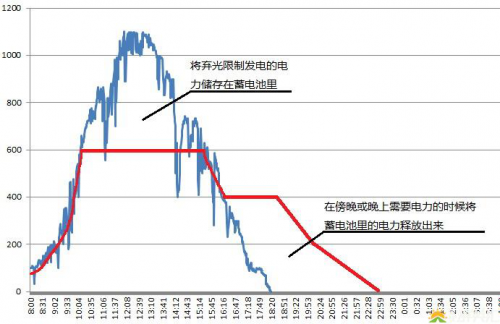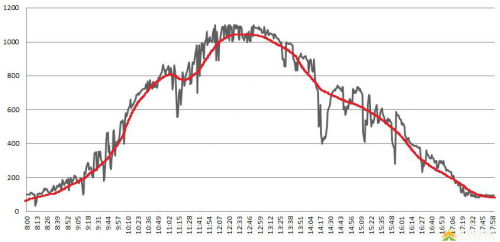Energy storage technology can achieve functions such as peak and valley filling, load tracking, frequency and voltage regulation, and power quality management. The energy storage system can also store excess electrical energy in the energy storage battery when the photovoltaic power station encounters light rejection to generate electricity, and sends the electrical energy in the battery to the grid through the energy storage inverter when the grid needs or peak electricity consumption, using peak and valley The electricity price difference creates greater economic benefits. 1. Battery charge and discharge balance control in energy storage system Since the current DC voltage of most photovoltaic power plants is around 600-800, to match this voltage, usually hundreds of batteries are required to be connected in series. Early battery charge and discharge controllers or relatively simple battery management systems (BMS) cannot fully monitor and manage the charge and discharge performance and working status of each battery. A large number of batteries are connected in series and parallel, and there will inevitably be individuals during their charge and discharge process The difference will cause serious battery charging and uneven power output problems, and eventually lead to system failure. In a large battery energy storage power generation system, an intelligent battery energy management system (EMS) is usually used to achieve the purpose of controlling the charge and discharge energy balance control in the battery, so as to ensure the stable and reliable operation of each battery. The central control system can generally adopt local control, bay level control and remote control mode. The central control system can receive the control instructions of the monitoring system to charge and discharge the battery, dynamically adjust the charge and discharge parameters according to the data provided by the battery management system, and perform corresponding actions to achieve closed-loop control of the charge and discharge voltage and current to meet the battery charge in each charge Various performance indicators during the discharge phase; process various warning information of the battery management system to ensure the safety of the battery. The battery management system also needs to have online monitoring of the voltage and temperature of each battery; online automatic periodic detection of the internal resistance of the battery; online balancing function, which can improve the consistency of the battery pack and delay battery failure and indicators by online charging and discharging of single cells Over-limit alarm and Other functions. 2. Power dispatch and smooth output According to the application goal of energy storage, the control strategy of energy storage system can be divided into autonomous mode and dispatch mode. Autonomous mode is generally aimed at fast-response applications, such as smooth short-term power fluctuations, frequency and voltage regulation, and power quality compensation. The dispatch mode mainly refers to accepting the demand dispatch of the upper-level power grid system. (1) Smooth output. Use the energy storage system to quickly absorb or release energy, smooth the photovoltaic grid-connected power generation voltage fluctuations, improve the system's active power and reactive power balance levels, and enhance stability. Photovoltaic power generation can adopt appropriate energy storage configuration and reasonable coordination strategies to improve the smoothing effect. The energy storage capacity is generally determined by the photovoltaic power generation grid smoothing strategy and energy scheduling strategy. Generally, if only to achieve the effect of smooth output, the capacity of the energy storage system is relatively small, and the mathematical model algorithm, control mode and response speed of the system will be higher. (2) Economic dispatch. The energy storage system can be used to improve the dispatchability of photovoltaic power generation. Through analysis of local power peak-valley time distribution and electricity prices, a charge-discharge control mode can be formulated to achieve low absorption and high throw to maximize economic benefits. It can also make full use of the situation of photovoltaic, wind power abandonment and wind abandonment, make full use of the power that the power grid cannot absorb, actively do the energy storage and economic dispatch within the power station, and use the energy storage system to achieve the translation of photovoltaic power generation on the time coordinate. Make it participate in power peak shaving, optimize system operation economy, and obtain better economic benefits. Economically dispatched energy storage systems usually have large energy storage capacity and large investment scale, and the energy storage system capacity should be optimized for the purpose of minimizing system cost. I suggest to use the AC side grid connection mode to establish this type of energy storage system. The energy storage power is determined by the difference between the actual output of the photovoltaic power generation and the target value. The energy storage capacity is generally determined by the photovoltaic power generation grid smoothing strategy and energy scheduling strategy. The integration of the solar cell system with the energy storage system mainly involves monitoring networks, control systems, equipment layout and safety facilities. For centralized photovoltaic power plants, energy storage can be configured before power conversion. The DC-side energy storage system can be configured based on the basic unit photovoltaic system, or the large-scale AC-side energy storage system can be configured according to the total capacity of the overall photovoltaic power plant to form a photovoltaic, wind power, energy storage, and other power generation systems. It can be used comprehensively and unified Dispatched microgrid system. Through reasonable access and effective deployment of photovoltaic power generation and energy storage power, the grid-connected power generation and access automation control problems of the energy storage system are solved, and the power transmission efficiency of the energy storage unit is improved. The photovoltaic power generation system and the battery energy storage system are connected to the grid. An intelligent monitoring and dispatching system is required to adjust the energy storage system's charge and discharge status and photovoltaic cell output in real time to achieve the purpose of coordinated and optimized control, and to achieve an optimal balance between energy storage life and photovoltaic output. At the same time, through real-time monitoring of the capacity status, photovoltaic output and load of energy storage batteries, the charging and discharging of storage batteries and the output of photovoltaic cells are reasonably arranged to achieve the purpose of maximizing the time of grid-connected power supply. The energy storage system cooperates with the photovoltaic power station to further improve the good matching between photovoltaic power generation and the power grid. By smoothing the power output and achieving "peak-cutting and valley filling", the problem of "large installed capacity and small power generation" of photovoltaic power generation is alleviated and greatly reduced The requirements of conventional photovoltaic power plants on the transmission capacity of the power grid are avoided, thereby avoiding the constraints on the power generation of photovoltaic power plants caused by insufficient power grid construction. The use of battery energy storage is currently the most efficient and effective method. The configuration of the energy storage system on the AC side of the power supply has a clear structure, strong versatility, easy implementation, and convenient power grid bidirectional energy dispatch. It is an ideal storage Energy solution is also a good way to solve the problems of current abandoned light and wind and unstable output of photovoltaic power plants. Energy storage power plants need not only the support of power grid companies, but also the government's corresponding subsidy policy support. Exposed Showers Set,Wall Mounted Hand Shower,Gold Rainfall Shower System,Three Function Shower Combo kaiping aida sanitary ware technology co.,ltd , https://www.kpfaucets.com
Figure 1. The effect of the smooth and smooth power output fluctuation of photovoltaic energy storage power station 
Figure 2. The function of energy storage power station to adjust the peak and valley of power demand
Understand what the control mode of photovoltaic energy storage system is
